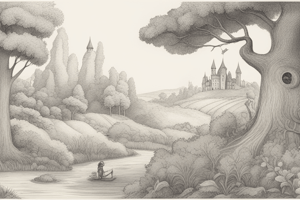Podcast
Questions and Answers
What is the primary function of the respiratory system?
What is the primary function of the respiratory system?
Gas exchange
Which of the following structures are part of the conducting airways? (Select all that apply)
Which of the following structures are part of the conducting airways? (Select all that apply)
- Bronchi (correct)
- Alveoli
- Trachea (correct)
- Nasal passages (correct)
The mouth serves as the primary route for air intake.
The mouth serves as the primary route for air intake.
False (B)
What role does the epiglottis play in the respiratory system?
What role does the epiglottis play in the respiratory system?
Match the following components of the pulmonary system with their functions:
Match the following components of the pulmonary system with their functions:
The blank serve as a barrier between the inside of the body and the external environment in the pulmonary system.
The blank serve as a barrier between the inside of the body and the external environment in the pulmonary system.
What is the significance of surfactant in the alveoli?
What is the significance of surfactant in the alveoli?
Which structure connects the oropharynx with the trachea?
Which structure connects the oropharynx with the trachea?
Flashcards are hidden until you start studying
Study Notes
Structural Organization of the Respiratory System
- The respiratory system is made up of conducting airways and respiratory airways.
- Conducting airways transport air, while respiratory airways participate in gas exchange.
- Conducting airways warm, filter, moisten, and remove foreign materials.
- Nasal passages are the preferred route for air entry, filtering, warming, and humidifying it.
- Mouth and pharynx serve as an alternate airway during nasal obstruction or when large volumes of air are required.
- The larynx connects the oropharynx to the trachea, functioning in speech and protecting the lungs from foreign substances.
- The tracheobronchial tree comprises the trachea, bronchi, and bronchioles.
- Bronchospasm can narrow bronchioles, impairing airflow.
Respiratory Airways
- Respiratory airways are responsible for gas exchange.
- They also inactivate vasoactive substances, convert angiotensin I to angiotensin II, and serve as a blood reservoir.
- Lobules are the smallest functional units of the lungs, each containing a terminal bronchiole, arteriole, pulmonary capillaries, and venule.
- Alveoli are the specific site of gas exchange.
- Alveolar sacs are thin-walled, cup-shaped structures with thin septa. A capillary network occupies most of the septa.
- An adult lung contains approximately 300 million alveoli, providing a large surface area for gas exchange.
- Type I and Type II alveolar cells exist. Type II cells synthesize pulmonary surfactant.
- Surfactant is a lipoprotein that reduces surface tension, allowing alveoli to remain open.
- Alveolar macrophages are responsible for phagocytizing foreign particles and microorganisms.
Studying That Suits You
Use AI to generate personalized quizzes and flashcards to suit your learning preferences.




